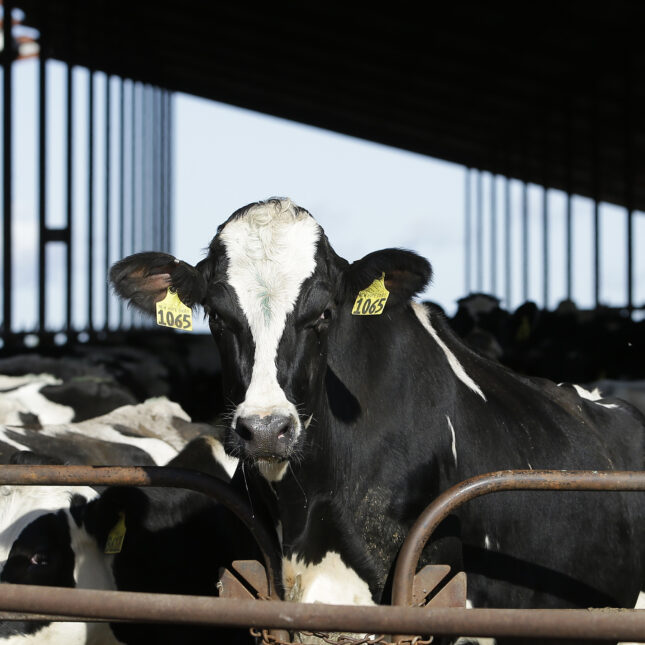
Facing increasing doubts that the U.S. can control the outbreak of avian influenza among dairy cattle, federal officials reiterated on Tuesday that they believe the country can still eliminate the H5N1 virus from dairy cows, even as it continues to spread to new herds.
“All the signs that we have are, with good biosecurity, with good farmer participation, we will be able to eliminate this,” Eric Deeble, the acting senior adviser for the H5N1 response at the U.S. Department of Agriculture, said on a call with reporters.
The reason for that confidence, Deeble said, is that investigations have shown it’s the transport of cows, as well as the shared use of equipment and vehicles, that is spreading the virus. That means that cutting the virus off at those points can contain it, he said, noting that officials have not seen new introductions of the virus to dairy cows from birds since the outbreak started, likely late last year.
“We understand that this moves with the cattle and with the people that are closely associated with them, so enhanced biosecurity should get us to a point where we can arrest the spread,” Deeble said. He added that the possible future deployment of an H5 vaccine in cattle — which is an idea that remains under discussion — could “further facilitate the elimination of this disease from the national herd.”
Outside experts are increasingly skeptical of that view given the ground the virus continues to gain. They’ve argued that the problems that have impeded the outbreak response from the beginning — from a surveillance system that isn’t keeping up with the spread of the virus to a lack of cooperation from dairy farms — haven’t changed dramatically. And they argue that the longer the virus persists in cattle, the more likely it is that it could mutate in such a way that would make it more transmissible among people.
The USDA has started providing more resources to farms with infected cows, which could improve the willingness of dairy farms to test their animals. But experts still believe that the poor tracking of the virus — officially, more than 155 herds in 13 states have reported infections, though it’s widely presumed that both numbers are undercounts — means officials don’t know the scale of the outbreak or all the herds that are affected. Surveys have also shown that farmers have continued to move cows even after they have shown signs of disease.
“There are no clear signs that the outbreak is or is about to come under control,” a report from the Norwegian Institute of Public Health last month stated, adding that “the probability of … persistent chains of infection is considered high.”
Deeble’s remarks came as health and agricultural officials provided an update on a cluster of human H5N1 cases in Colorado.
The five cases (four are confirmed, one is still considered presumptive) were among people who were involved in culling birds at a poultry farm with an H5N1 outbreak in Colorado’s Weld County. But the available evidence suggests that the virus possibly reached the 1.8-million bird poultry farm from an infected dairy herd.
On the press call, officials noted that there have been infected dairy herds in Weld County. They also said that a genetic sequence from one of the human cases indicated that the virus was related to the version that’s spreading among cows. Notably, the genetic sequence of a key component of the virus — the hemagglutinin subunit — was an exact match to the hemagglutinin sequences from two earlier human cases tied to the dairy outbreak, officials said.
“That does raise the possibility that this virus was transmitted from a dairy herd in Colorado to the poultry farm,” Nirav Shah, the principal deputy director at the Centers for Disease Control and Prevention, told reporters. “That is a hypothesis. It is a hypothesis that needs and requires a full investigation. But that is a hypothesis at this point.”
The five Colorado cases were all mild, Shah said. The people had different symptoms, with some experiencing the more traditional flu signs of fever and cough, and others having conjunctivitis, a symptom that’s been seen with some of the dairy workers who’ve been infected during the outbreak.
The human cases also underscored some of the challenges authorities face in seeking to prevent spread from animals to people. Health officials have been urging dairy workers to wear personal protective equipment in milking parlors, for example, given the sky-high levels of virus in cows’ udders and their milk. But milking parlors can be hot and stuffy, meaning it’s not comfortable or feasible to wear masks and goggles.
Workers involved in culling poultry with H5N1 outbreaks — “depopulation” in the parlance of agricultural officials — are meant to wear full PPE, from boots to suits to masks and goggles. But officials noted that when the culling was taking place, it was over 100 degrees in Colorado. Moreover, the industrial fans that were meant to cool down the barns where the culling was taking place were so strong that workers had a hard time keeping their masks and goggles sealed to their faces. Plus, the fans were whipping up birds’ feathers, which can carry the virus.
The culling method used on this farm — which requires workers to pick up chickens and place them in a cart where they are euthanized with carbon dioxide — also meant there was lots of contact with the birds, officials said.
“We understand that PPE use was not optimal, particularly the masks and the eye protection,” Shah said. He added, however, that “these factors do highlight a pathway to prevention,” with better engineering and PPE use possibly able to avoid future cases.
To submit a correction request, please visit our Contact Us page.











STAT encourages you to share your voice. We welcome your commentary, criticism, and expertise on our subscriber-only platform, STAT+ Connect